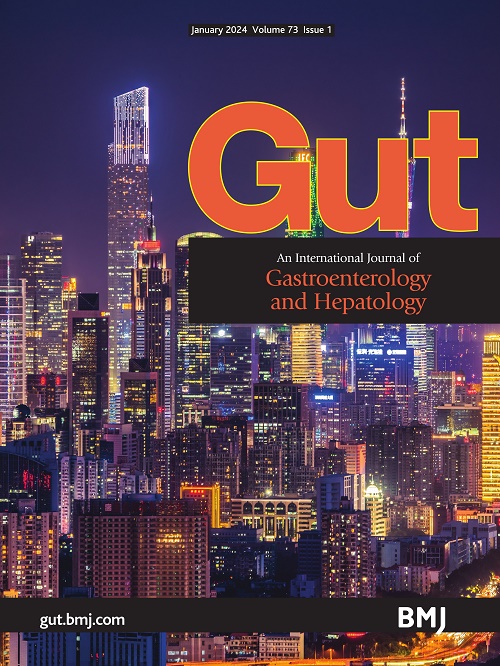Trends and cross-country inequality in the incidence of GI cancers among the working-age population from 1990 to 2021: a Global Burden of Disease 2021 analysis
IF 23
1区 医学
Q1 GASTROENTEROLOGY & HEPATOLOGY
引用次数: 0
Abstract
Background GI cancers pose an increasing global health burden, with their impact on the working-age population (WAP) aged 15–64 years remaining largely unexplored despite the crucial role of this group in societal and economic well-being. Objective To assess trends and cross-country inequality in the global burden of six GI cancers from 1990 to 2021 among individuals in the WAP. Design The 2021 Global Burden of Disease study dataset was used to obtain estimates of GI cancer incidence and 95% uncertainty intervals, including the number of cases, crude incidence rate and age-standardised incidence rate (ASIR). WAP GI cancer epidemiology was assessed at the national, regional and global levels, evaluating trends from 1990 to 2021 from overall, local and Sociodemographic Index (SDI) perspectives and using standard health equity methods to quantify cross-country inequality. Results Colorectal cancer exhibited the greatest burden of GI cancer among the WAP in 2021. From 1990 to 2021, the number of GI cancer cases rose by 51.9%, although the ASIR declined by 23.4%. These rates exhibit geographic variation, with the most cases and the highest ASIR in China and Mongolia, respectively. Incidence was disproportionately concentrated in higher SDI countries, and worsening inequality was evident over time. Conclusions While the ASIR of GI cancer is trending downwards among the WAP, high incidence rates, regional variability and an unequal burden of disease emphasise the need for flexible, targeted medical interventions to support policymaking and medical resource allocation. Data are available in a public, open access repository. Data are available in a public, open access repository. Data from the Global Burden of Disease (GBD) study in 2021 can be accessed using the GBD Results Tool (1990年至2021年工作年龄人口中GI癌症发病率的趋势和跨国不平等:2021年全球疾病负担分析
胃肠道癌症造成的全球健康负担日益加重,尽管15-64岁的工作年龄人口(WAP)在社会和经济福祉中发挥着至关重要的作用,但它们对这一群体的影响在很大程度上尚未得到研究。目的评估1990年至2021年WAP人群中6种GI癌症全球负担的趋势和跨国不平等。设计使用2021年全球疾病负担研究数据集来获得胃肠道癌症发病率和95%不确定区间的估计,包括病例数、粗发病率和年龄标准化发病率(ASIR)。在国家、区域和全球各级评估了WAP GI癌症流行病学,从总体、地方和社会人口指数(SDI)角度评估了1990年至2021年的趋势,并使用标准健康公平方法量化了跨国不平等。结果在2021年WAP中,结直肠癌是胃肠道癌症的最大负担。从1990年到2021年,虽然ASIR下降了23.4%,但胃肠道癌症病例数上升了51.9%。这些比率表现出地理差异,中国和蒙古分别出现最多病例和最高ASIR。发病率不成比例地集中在SDI较高的国家,而且随着时间的推移,不平等现象明显恶化。结论:虽然胃肠道肿瘤的ASIR在WAP中呈下降趋势,但高发病率、地区差异和不平等的疾病负担强调需要灵活、有针对性的医疗干预措施,以支持政策制定和医疗资源分配。数据可以在一个公共的、开放访问的存储库中获得。数据可以在一个公共的、开放访问的存储库中获得。2021年全球疾病负担(GBD)研究的数据可以通过卫生计量与评估研究所(Institute for Health Metrics and Evaluation)维护的GBD结果工具获得。GBD数据不需要许可用于非商业用途。
本文章由计算机程序翻译,如有差异,请以英文原文为准。
求助全文
约1分钟内获得全文
求助全文
来源期刊

Gut
医学-胃肠肝病学
CiteScore
45.70
自引率
2.40%
发文量
284
审稿时长
1.5 months
期刊介绍:
Gut is a renowned international journal specializing in gastroenterology and hepatology, known for its high-quality clinical research covering the alimentary tract, liver, biliary tree, and pancreas. It offers authoritative and current coverage across all aspects of gastroenterology and hepatology, featuring articles on emerging disease mechanisms and innovative diagnostic and therapeutic approaches authored by leading experts.
As the flagship journal of BMJ's gastroenterology portfolio, Gut is accompanied by two companion journals: Frontline Gastroenterology, focusing on education and practice-oriented papers, and BMJ Open Gastroenterology for open access original research.
 求助内容:
求助内容: 应助结果提醒方式:
应助结果提醒方式:


